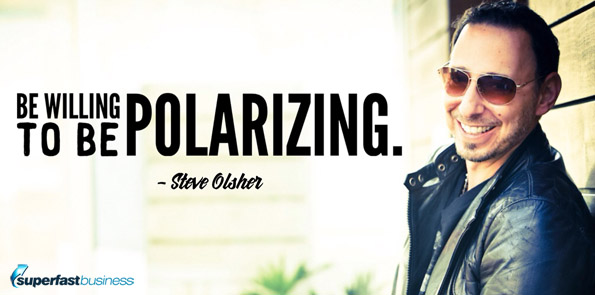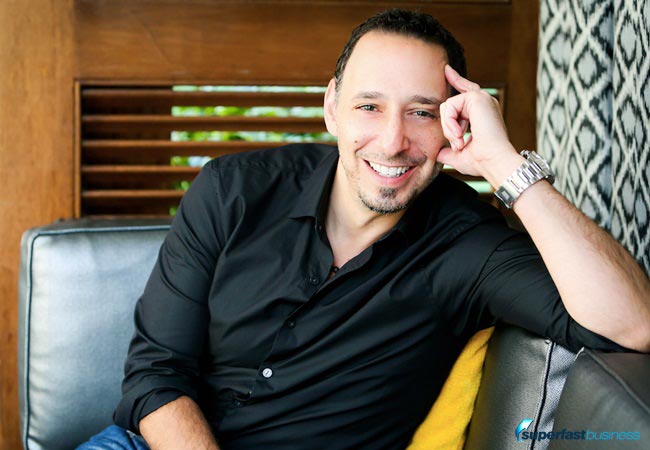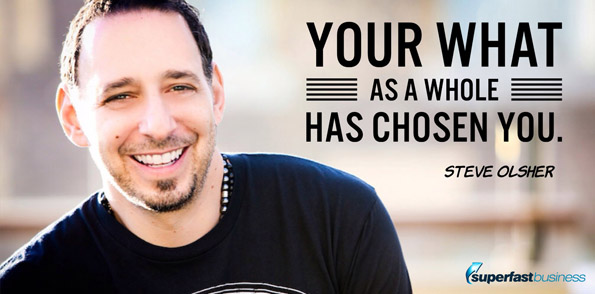Podcast: Download (Duration: 39:19 — 36.2MB)
Get Notified Of Future Episodes Apple Podcasts | Spotify | Amazon Music | Android | Blubrry | Gaana | TuneIn | Deezer | Anghami | RSS | More
Topic highlights:
01:26 – A non-alcoholic nightclub
04:13 – What is your WHAT?
07:06 – 3 pillars to discover your gift
09:23 – The 7 seeds of your soul
10:47 – Gift or gifts?
15:12 – Why you should choose your side
19:26 – How to incentivize your followers
21:05 – Gamification
26:12 – The secret to wealth
27:08 – How to get 50,000 subscribers in a month
33:48 – The SAS platform
35:45 – Wrapping up
Experience amazing transformations in your life and business. CLICK HERE
Transcription:
James: James Schramko here. Welcome back to SuperFastBusiness.com. Today, we’re going to be talking to Mr. Bold. Welcome to the call.
Steve: [laughs] You know it’s funny. That is actually what my license plate says. I was stunned. I moved from Chicago to California. I went there and I was like, let me see if I can get that license plate. So it was 39 million people in California, only one Mr. Bold. So there you go. And I got the plate.
James: So, of course I’m actually talking to Steve Olsher from steveolsher.com. You started off as a radio DJ.
A little background on Steve
Steve: A radio DJ, a nightclub DJ. I actually owned my own nightclub. Yeah, man. It’s like all that broadcast music, that production side of the equation, it’s in the blood and I can’t do anything about it, it’s there.
James: One of the interesting things in your bio Steve is that you had a non-alcoholic nightclub.
Steve: Yeah. Don’t ask what we were smoking around the table, but the name of it was The Funky Pickle. So that’s what we came up with. And yeah, at 19 years of age, I owned my own club. We catered to the teenagers early because it was a non-alcoholic club and went to bed about 11:30 or so, closed down, cleaned up, re-opened at midnight, open until 4, 5 or 6 in the morning for those 18 and over. Yeah man, I opened the doors when I was 19 and dropped out of that when I was about 21.
James: So the drinking age, is it 21?
Steve: It is 21. Yeah, which was, whenever people say, “How do you open a club when you’re 19?” Well, it was a non-alcoholic club. It’s kind of like a youth center or something that just played music. It’s kind of basically what would work.
James: And then you did the most natural thing possible and went into selling liquor online.
Steve: Well I thought, look man, if you’re going to go from the non-alcoholic scene anyway, you might as well jump like straight into the bar. Not even like behind the bar, I mean like just ingrain yourself into the wood of that bar. That’s what I did for the next 9 years. What I’m talking about is liquor.com, which is actually a domain and a company I still own this day.
James: You certainly have the early mover thing. I guess in your industry, you would’ve seen people come up maybe even after you or around the same time and approaching marketing in a different way. Like Gary V. comes to mind, making big waves in that one market.
Steve: Yeah.
James: Did you see him coming?
Steve: Early on, actually because we launched on CompuServe’s Electronic Mall in 1993. So that company actually started as a catalog company and then we came online in ’93 on CompuServe and built one of the first fully-functioning commerce sites in ’95, which then became a .com in ’98. I think I saw Gary for the first time, it must have been right around the turn of the century there, I think when he and I first connected.
James: Well I saw him many, many years later right after he was successful at a conference about eight or nine years ago. That really was the benchmark for content marketing, the video content, the show-based premise. It certainly has built him a huge amount of authority. That’s what I want to talk to you about today. I want to talk about influence and how you go about, firstly finding what is your what, which is a topic of one of your books, and then once you know that, how do you make sure that other people know about you? That’s what we’ll be talking about today.
So firstly, tell me just a little bit about What Is Your WHAT.
What Is Your WHAT?
Steve: So What Is Your WHAT, is first and foremost the name of the book that I wrote in 2012 and subsequently put on the New York Times list, but it’s also the description if you will of the framework that I created to help people answer that core question of why they’re here, how they’re most naturally wired to excel, and how they’re going to impact not only those who share their lifetime with them but also those of lifetimes to come.
James: So you cover legacy as well.
Steve: It’s really to me all about legacy. I mean because at the end of the day, we’re going to impact our folks that share this lifetime with us but I do think that each of us has the ability to leave something, leave that legacy, whatever you want to call it that survives our physical existence here on this planet.
James: It’s kind of why we have kids isn’t it?
Steve: Well then there’s that.
James: It’s like wired into us to keep propagating and survive.
Steve: Right. Yeah. And don’t leave them too much money because I don’t think that does anybody any good. But that’s conversation for another day.
James: Well I do really well at making sure that won’t happen. I feel like a reverse ATM. So you said to me once before: write the book you need, or something to that effect. Tell me about that.
Write what you need
Steve: Yeah. So in author land, you write the book that you most need. At least, that’s been said.
“Write the book that you most need.”
For me, even though I had been doing various entrepreneurial endeavors over the years, it really was a function of not really feeling comfortable in my own skin. Like I was really just going through the motions of creating something for the sake of creating it but not really doing something that put a fire in my soul and really just give me the urge to jump out of bed every day in the morning.
So this is kind of the byproduct if you will of trying the Myers-Briggs, and the what color is your parachute, and the SrengthsFinders and so on. You know look, I’m not knocking the modalities but they just didn’t really get me to the answers that I needed. So I started toying with this whole process of what do you really need to get to the point where not only doing something that feels as natural to you as breathing but also is monetarily rewarding because like I’m not one of those people that will tell you, you have to succumb to life as a starving artist simply because you’re compelled to draw.
James: Yeah. I covered a topic related to this in a previous episode talking about ikigai, a Japanese philosophy, which is similar, but like a more advanced version of The Hedgehog Principle that we hear about in Jim Collins’s book. So it’s a fair bit of a discussion around finding something that you like, something that you’re good at that people will pay you for, etc.
Can you tell me in your What Is Your WHAT, what is the process? If we’re listening to this podcast, we’re still not sure what we want to be when we grow up. Where do we start?
What is the process?
Steve: Yup. It really begins with understanding what that core gift is. Note I didn’t say gifts, right? I believe that we each have a predominant gift. Not it might be 51%, 49% gift, but I do believe that there is one that outshine the other. So it could be anything, it could be entertaining, it could be your core gift, it could be healing, it could be enrolling, it could be protecting. I mean there’s a long list of what those core gifts could be. But that’s certainly going to be step one of the equation. But you really got to think of the what-is-your-what framework kind of like a tripod because the gift is just one part. And it’s like the Myers-Briggs things, it’s like I’m an ENTF or whatever I am, it’s all well and good, but it’s like WTF, like what do you do with that?
It’s the same thing with the gift. It’s like that’s great to know that I’m an entertainer or communicator by nature. But now what? Which leads you then to the second part of the equation, which is understanding the vehicle. What is the primary vehicle that you will use to share that gift. So let’s say for instance healing might be your core gift. Well nursing could be the vehicle that you use to share that gift. Now in of itself, that’s definitely a good step forward. But like a tripod, without the third leg, it’s still really isn’t as powerful or effective as it could be, which leads you to the third part of the framework, which are the people.
Who are the people that you’re most compelled to serve? What I found is that most people will go through life. I mean we’re talking about 99% of the world and change will go through life without having clarity around one part of the equation, let alone all three.
James: Right. So if someone’s thinking that they’re not sure what their gift is, how do they identify that?
Steve: For the sake of brevity here, I mean there is a process that I take people through because the reality is that you have to do some digging. You have to do searching, and the framework that I created, specifically pointing to the gift, is that the component here of the discussion, it’s a pretty long process. I actually created something called the 7 seeds of your soul, which is the exercise that is specifically designed to help you get to that core gift because I believe that that gift and really your what as a whole has chosen you. And it’s not that what you have chosen.
When you look at your vehicle, when you look at your people, those are more organic, those are more fluid, those can change throughout your life depending on circumstances and things you’re exposed to, etc. But your gift is really, it’s in your DNA, man. It’s like there’s really nothing you can do about it other than live in denial or accept it. But for purposes of this discussion, I mean because it is probably the most important piece because you can’t do anything about it other than bring it to the surface, the other stuff you can choose, it’s a really kind of the difference between the what and the why. The what you can do anything about, the why you could choose.
James: One thing that I have reservations about would be to put yourself in a box and to create false barriers or limits. Certainly, if I were to think about my gift, I would say that it’s definitely changed as I’ve gone through life. I’m at the tender age now of somewhere around 45, I think.
Steve: Well let’s talk about that because I would actually challenge you that the gift hasn’t changed. I bet you the vehicle has changed and I bet you that the gift has changed. But I’d be curious. People have changed.
James: The thing that always confounded me was any of those personality things or whatever. I’d often end up square in the middle of four quadrants or like a horoscope; I could see every single one of them being applicable.
Steve: So when you look back, what do you believe has changed? What did you do that you now look back on like that was night and day to what it was that I was doing before that or after that?
James: Well some of the things that stand out, I was always very systemized and analytical, but now I’m extremely creative and expressive. I would’ve thought there may be other ends of the spectrum.
Steve: What was the result of that way of being? What are the results of the creative way of being?
James: It made me a particularly good salesperson and able to run large businesses successfully because I was able to solve puzzles basically.
Steve: So I bet if we were to dig a little bit deeper, I bet you your core gift is enrolling.
James: Yeah. I don’t know what enrolling is so I can’t answer.
Steve: Basically, it’s like getting people to see what you see and getting them to basically subscribe to that as something that they need to either initiate, or implement or consider.
James: Yeah I’d say that. But then if you say other type of gift, I might relate to them as well.
Steve: [laughs]
James: [laughs] I’m very adaptable. Anyway, I don’t want to bog it down too much. But it’s interesting and I know that our listener wanting to find out more about if you do feel like you want to go through your 7 soul steps. What did you call them?
Steve: Yeah. The seven seeds of your soul.
James: Do you want to go through the seven seeds of your soul? Go and get the book, which is called What Is Your WHAT? And go through it. Have some fun with it. That’s cool. I think the interesting thing to me and perhaps to our listener as well, let’s say you’re Steve Olsher AKA Mr. Bold, and you’ve got this fantastic book that you really needed to write and you’ve written it, you mentioned, you sort of dropped it casually, New York Times bestseller, how do we orchestrate marketing to become influential with our thing? Whether we’re a world-class podcast engineer, whether we’re an author on any other topic, or if we’re just damn good at building websites, whatever that skill is, how do we make sure that other people know that we’re that good and are prepared to be enrolled?
How to orchestrate marketing
Steve: So obviously, you’ve been doing this long enough to know that there are a thousand ways to get to the same destination.
James: That’s like a, like I think there’s a thousand gifts.
 Steve: Right, yeah, exactly. But you know, from my perspective, it all boils down to be willing to be polarizing. That takes lots of different forms. I mean like for one, part of the reason why I was able to get the book in so many hands because to this day, I still give a book away for free. Like if you go to whatisyourwhat.com/free, you can get the book for free. That was part of our process going into this, which is you have to get what you’re doing into as many hands and in front of as many eyeballs as humanly possible, and sometimes, that means doing things that others aren’t willing to do. And it’s also a matter of really a way of being in an opinion that is not neutral.
Steve: Right, yeah, exactly. But you know, from my perspective, it all boils down to be willing to be polarizing. That takes lots of different forms. I mean like for one, part of the reason why I was able to get the book in so many hands because to this day, I still give a book away for free. Like if you go to whatisyourwhat.com/free, you can get the book for free. That was part of our process going into this, which is you have to get what you’re doing into as many hands and in front of as many eyeballs as humanly possible, and sometimes, that means doing things that others aren’t willing to do. And it’s also a matter of really a way of being in an opinion that is not neutral.
“Do things that others aren’t willing to do.”
I mean it’s like so many people are just kind of writing that straight line down the center. For me, there’s no life in the middle. You can live a life in the middle but it’s always been a function of I want people to line up on either side of me and have an opinion one way or the other. And whether you love me or you hate me, I don’t care. It’s really just a function of I want you to know that I was here.
Before we got on this call here, I started sharing with you some of the ways that were marketing What Is Your WHAT and we continue to market it. But it’s really all about how do you touch people’s soul with the work that you do. And given my background in music, given my background with DJing, etc., we are actually creating now a song and a video that we will put onto the charts. I mean that is not just our goal that will absolutely happen. I don’t know of any other author that has done something similar, where they actually have taken the name of their book, the name of their movement, whatever it might be, and created a top 40-type song with it. So that literally every time people hear this music, not only will they think of course of the song, but they’ll think of you and they’ll of your movement.
You’ve got to do things. It’s all about new media, man. Really when you come right down to it, here we are in early 2016; you’ve got to start leveraging the tools that are available to you. If you are going to get enough folks to know who you are and what you’re doing and what you’re about, so that you get those clicks, so that you get those leads, so that you get the conversations, so that you get the revenue, you have to go to where the eyeballs are. It amazes me that so many people right now are still in this mentality of “if you build it, they will come.” It just doesn’t work like that.
James: Yeah, it’s interesting you combining different mediums. I think some of the great visionaries have been there. Movies are pretty good at that combining soundtracks with movies and franchising it out that way. It makes sense that smaller operators like us can see what’s happening in bigger markets, like a new PlayStation game when it gets launched. There’s a huge product launch around it, posts about it coming. We get excited. They have bonus levels that you can get if you get the first edition or pre-order, etc. Some marketers are incorporating this stuff into their routine. So that’ll be interesting, the song. Maybe you’d share it with us on the podcast here.
Steve: Yeah, absolutely. I’d be delighted to do that.
James: We’ll play it out at the end. So you’ve got to be polarizing, you’ve got to do what others don’t do. Are you merely talking about being contrarian, or you’re talking a bit more about innovation?
Contrarian or innovation?
Steve: Both for sure. But it’s also sort of a gamification. You’ve got a look at what you’re doing. And you’re really good about this, man. You understand the metrics, right? You understand just how old sort of the numbers work. But numbers are really just a byproduct of the gamification process. It’s like how do you beat your best? That is one of the things that we believe, we strongly believe that in this market and moving forward, that the way to really build a brand, the way to really build a company is to have others do it for you.
We used to just beat our heads up against the wall buying media. We try to put it in front of people in ways that frankly weren’t trackable and had very little ROI. Whereas today, everything that you do is trackable and everything that you do has the ability to be gamified where your people, your tribe, your core followers, whatever you want to call them, can build your business for you. You just have to incentivize them and give them a reason to do it.
How to incentivize your followers
James: Right. So how do you incentivize your followers?
Steve: So one of the ways that we do it at this juncture, so there’s a couple of tools. Is it cool to share a couple of tools?
James: Sure. I know every single person in business is a sucker for tools.
Steve: [laughs]
James: Myself excluded of course. But everyone else loves tools.
Steve: You’re right. Of course. And so, you can’t deny the power of Facebook. I mean it is what it is. A billion users. But now is it Instagram, is it Snapchat? No. But it’s its own animal and there are lots people there. One of the tools that we really like right now is something called UpViral. I don’t know if you’re familiar, you’ve probably seen it James. But basically, what it does is it gives you the ability just through software to gamify whatever it is that you’re doing. It’s a function of basically creating whatever that appealing magnet is, whether it’s a book or if it’s an event or whatever it might be, and then giving people the opportunity to share it with others and basically unlock various levels as you said, like with a game. It’s the same thing except with business.
You can use this to basically get more people to become your on-page sales force, where they do all of your marketing for you and they get rewarded. It’s a very simple, very easy tool, but it’s very, very effective. You can combine it with something called Connect Leads. The two together, we’re finding a lot of success with it right now. It’s really just replacing the gamification.
What is gamification?
James: Yeah. I think gamification is going to be big. It’s easy to say the word. I’m sure we’re probably assuming that everyone knows what it means. But we should probably give a couple of examples. I can start with one.
Steve: Sure.
James: Every year, Dean Jackson comes and stays here. Just near me, we hang out for about a week, and he’s often sharing stories that he gets back from the singularity movement and Peter Diamandis. He’s talking about staircases that have piano keys painted on them that play a sound when you walk on them. So people will take the stairs instead of the elevator.
Or a rubbish bin where it’s got the sound of like a missile. If you throw rubbish in it, it makes a *whistle-boom* kind of sound. And people are literally looking around for rubbish to throw in the bin so that they can hear this sound. So it basically is a great way to reward the behavior that you’re trying to get. That’s my very simple definition.
Steve: Yeah. I think I’m going to apply that to the toilet, just to see how that goes. I think my kids would love that. That would be a great way to potty.
James: Well even those, and ladies may not be able to relate to this, but sometimes if you go to a men’s bathroom, they have these urinals. It’s basically just a wall that you pee against. And sometimes, they put little pictures of a fly and you get to aim for it. You know, it improves aim. It’s just a natural thing to reward the behavior they’re trying to get.
Steve: We need as much practice as we can get.
James: How did we get to be talking about urinals on this podcast? Let’s get it back. Let’s clean this up.
Steve: So, it’s interesting that you bring up Peter because I mean the whole XPrize concept is really based upon gamification. Where they come up with an initiative, whatever that initiative it might be; putting people into space, or literacy or whatever it might be, and they put up a prize of whatever, a million, 2 million, 10 million, whatever that prize that might be, and teams around the world compete to create the solution and the winning team gets the money, right? So instead of investing a million, 2 million or 10 million into one company and tried to get them to find the solution, they have these teams around the world that compete so new they’re getting, $100, $200, $500 billion dollars going into this process for the same amount of money as the initial investment of 1, 2 or 5 or 10 or whatever it might be. I mean that is a perfect example of how to gamify something. How could you gamify teaching people how to read? Well, this is one of the ways to do it.
James: Great. So basically if you’ve found what your what is, and you want to share it with the world, you’re going to look at being polarizing, doing what others won’t do, and having a look at some trends of gamification to see if you can get an innovative approach. So that’s what you’re hoping to do with the music track is to play around with the market a bit and give them something that’s fun and also is carrying your message.
Steve: Yeah. I will add to that James that the other side of the coin here is we often as business people focus on the wrong things, which is we focus on the front end, which is the products and the services and the revenue. When in fact, if you look at the what is your what equation and you look at the final piece of the puzzle, which are the people that you’re most compelled to serve, if you switch and realign your thinking, to focus first on those people, you’re going to find yourself operating in ways that are very different than when you put the products and the services first.
Do you, I mean like really consider the people that you are most compelled to serve? Then we’re back to nothing. It’s almost like starting with the offer first and then winging the curriculum.
James: Well you know Gary Halbert talked about the only advantage he would want is a starving crowd. Start with the market first and then it’s easy to find products and services that fit that market. It’s way harder to find the market to fit the product or service. I agree with you. A lot of people do this completely ar*e about, and they come up with this great idea. They put those time and energy into developing a thing. All the time, you know what the driver is? It’s the next mortgage payment. It was never, ever about the customer or the market they’re serving. I’m totally aligned with you on this one. I’ve always had this lifetime customer approach, which means, one of the things I thought you we’re going to say but didn’t is that most people spend the majority of their time focusing on traffic and getting that next customer. Instead if they just focus on serving that existing customer, they’ll find many ways to expand their revenue by just offering more and more value. Really, it’s the secret to wealth, isn’t it? Create value for many people.
“Create value for many people.”
Steve: It is. Yanik Silver talks a lot about that. In terms of he never creates new products, in terms of he only creates products that go to an existing market, it’s very smart. Selling new products to an existing market first before you begin finding any new market for a product; obviously Yanik has his way of looking at that, but same concept. It’s genius. Absolutely.
One of the things that I do want to share is one of the ways that we really have built our business and our traffic and our engagement at liquor.com to the tune of we’ve got about a million six on the email list now, we got about 3 million uniques to the site a month, one of the things that we have found that we do very well, and this is something that I encourage you to do is to look at your vertical in new ways and see that vertical as your opportunity to partner and create a dynamic that frankly is only available to those who are aligned with you in the start to finish process.
Let me give you an example because it probably just sounds too theoretical. For example, if you’re a massage therapist, like that’s your thing. If you think about your vertical, who’s in your vertical? You’ve got people that make massage oils. You’ve got people that make the massage tables. You’ve got people who create the music that are playing during the massage, and the candles, the teas, whatever it might be. All of those people that are in that vertical that serve in one way or the other, directly or indirectly, your client, those are all potential partners that you could collaborate with.
And that’s one of the things that we do really well at liquor.com is we are consistently finding those people in our vertical and those who complement what we do to work with them and create what we would call a general co-reg type opportunity where we create this big, huge carrot, whatever it might be is the giveaway; it’s ticket for four to the Super Bowl, you name it, whatever that might be, and then we partner with people in our vertical and we all drive traffic to the same giveway and with the opt-in, they are agreeing to receive correspondence from all of the participating partners.
We had, on a slow month; we’ll add about 50,000 subscribers to our database using just that, just using that method alone. And then most months, we’ll add closer to 100,000.
James: Right. Just a couple of points on that. Great description of what you’re doing there as well. I think just in case someone’s not sure of what a vertical is. Think of it like a river that everything in that river, upstream or downstream is sort of flowing in the same body of water. So it’s an industry classification in this case. That’s what vertical is. So you’re looking upstream and downstream and saying, what comes before or after your service, or what does every single person in the river have? That’s how you get together and you basically coordinate this vertical domination with this opt-in that you all share. That is a very clever thing to do. By industry vertical, certainly.
There’s also an alternative one, which I experimented when I was in the Mercedes-Benz dealership. We had no marketing budget. When I started with the dealership, it was losing money. My goal was to turn it around. So I had to come up with ways to generate sales without any marketing budget. So what I did is I grouped together people who shared the same customer type and I pulled people from different verticals.
So I put on events where I would bring in the best of the AMG vehicles and I would invite an art gallery to display their art on the walls, and I would invite a wine company to supply one to the group, and I would invite a financial planning investment bank to invite their top-level customers to come and enjoy some wine and art, and I would invite a high-end music supply to supply the sound system and to put some displays there, to expose them to the Mercedes-Benz, art-loving, wine investment crowd.
And what we did is combine, we’ve managed to stuff the shows full of thousands of people by combining everyone who had the similar customer who had a non-compete situation. So it was a really great way to create an event. And then of course we made a free giveaway that collected the names and details of every single person that came, and we’re able to pull them as well.
So there’s two ways to approach it. We’ve just outlined. If you’re not already doing something like that, get around the other people in your market space and see how you can complement them. And if you can share the same type of customer, or if you can bring together an authority in your vertical, what a great technique.
Steve: Yeah. And as you said, you had no budget.
James: I had no budget at all. One of the interesting things is as the general manager, I took over the website and the marketing team among every other team and we started from scratch with the website and we built up an email list of 10,000 people. In Australia, we were lagging behind the United States; especially this is about 12 years ago. So 2003 or 2005, sort of when Facebook was starting, and Twitter and all of that.
I came up with a good sort of opt-in that we took offline. And to this day, one of the great ways to build a great online business is to utilize offline channels, whether it’s direct response marketing, attending live events, speaking for platform, publishing books, going to trade industry fares. You can collect great lists by doing that properly. And if you combine that with an online element, you’ve got a nice sort of hybrid business that will have an advantage over purely online businesses or purely offline businesses.
The SAS technique
Steve: Yeah. And it’s also interesting to look at where we are generally in terms of what are some of the ways that you can as you said earlier, how do you then take your what or whatever you want to term it as and build that movement and increase your influence, increase your authority, get that visibility and exposure. It really boils down to making sure also James that you’re taking advantage of, I will put that initials as SAS, instead of ASS, just because, you know, it’s better that way. But it works either way, which are the three ways of getting in front of people using what you already have through Syndication, Amplification and Simulcasting.
A lot of people aren’t taking advantage of all of the amplification, syndication and simulcasting opportunities out there. And I know James that obviously you’ve been in this space for a while. You have a lot of written stuff as well as audio and video etc. It dumbfounds me that people aren’t doing is taking advantage of some of the tools like ZergNet and Outbrain and Taboola for their written content. Are you familiar with those three?
James: Yes. That’s basically putting little featured stories underneath major publications.
Steve: Yeah, yeah. And it’s extremely effective. The cost per thousand is very reasonable, very fair.
James: It really blends in too, as the copywriting great said that it’s marketing disguised as news. It’s going to be far more impactful. I think they call it native advertising.
Steve: Native, exactly. I mean with liquor.com, on a slow month, we’ll put about 250,000 unique visits over to the site through Zergnet alone, and then 300,000 to 350,000 uniques just from Zergnet. It’s an example. That’s another way for you to think about really getting that message to the masses in ways that are not free but aren’t nearly as expensive as you might think they would be.
Wrapping up
James: Steve this is good stuff. We’ve come a long way in this call. Let’s just wrap with what we’ve covered so far. We’ve been talking to Steve Olsher, Mr. Bold. We’ve followed his journey from having a non-alcoholic nightclub to having an online liquor store. But really importantly, we’ve talked about how you might go about finding what is your what, great quote there. Write the book you most need. I like that one Steve.
And once you know what you’re what is, how do you actually let other people know about it? We covered the SAS formula: syndicate, amplify, simulcast. We’ve talked about how you can corral an entire vertical and own that space. We’ve talked about how you might bring in different verticals but have the same customer in common. We have talked about gamification. We’ve talked about the gift and gifts. And also, Steve’s great new song.
So Steve, what have I forgotten to ask you that I really should have that would be pertinent?
Steve: Ah, what I like to do for fun.
James: What do you like to do for fun?
Steve: Not nearly enough, I work too damn hard. [laughs]
James: Oh, I can’t say that.
Steve: I know you don’t.
James: I love my surfing.
Steve: I know you do man. Brazilian jiu-jitsu is my thing. I’ve been doing Brazilian jiu-jitsu for about 16 years now.
James: You sound like about a brown belt.
Steve: You got it man. Dead on. Or you saw the picture? [laughs]
James: Yeah. I read it on the website. [laughs] That’s good. Good for you. Well, enjoy your jiu-jitsu. I hope you get to do a little more of it. Thanks for producing the stuff you have been producing. I’m sure you’re helping a lot of people figure out what they’re supposed to be doing in life with their core gift and what vehicle they can use to deliver that and which people they’re serving.
Remember, it’s good to be polarizing, and you could do that with innovation. You could be contrarian. You can gamify. Steve, will you play us out with your tune?
Steve: I would be delighted.
James: Do the DJ intro.
Steve: [laughs] And here right now is the brand new single, well it’s a snippet of it anyway, which is called What Is Your WHAT.
*music playing*
Get exclusive business resources and coaching inside JamesSchramko membership
Liked the episode? Subscribe to the podcast on iTunes
Follow us on Instagram for inspirational quotes











This is a great discussion. And I think you will find (JS) that enrolling is selling! I found it interesting that you said you were now more creative, but I think your gift is still “enrolling” – your vehicle simply gave you scope to be creative in the role – I remember you recently saying on the FWF that you “didn’t get Facebook” (or social media??) not sure exactly which you said – and yet now you are on FB a lot – you are an evolving person, and that’s what makes you an incredible role model! But you’re still an “enroller” at heart! lol ;)
This is a great discussion. And I think you will find (JS) that enrolling is selling! I found it interesting that you said you were now more creative, but I think your gift is still “enrolling” – your vehicle simply gave you scope to be creative in the role – I remember you recently saying on the FWF that you “didn’t get Facebook” (or social media??) not sure exactly which you said – and yet now you are on FB a lot – you are an evolving person, and that’s what makes you an incredible role model! But you’re still an “enroller” at heart! lol ;)
Thanks Kate,
I dont spend much time on Facebook :)